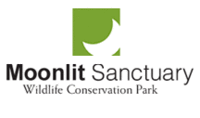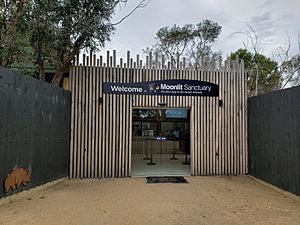Moonlit Sanctuary Wildlife Conservation Park facts for kids
 |
|
| Date opened | 2001 |
|---|---|
| Location | Pearcedale, Victoria, Australia |
| Land area | 25 acres (10 ha) |
| Coordinates | 38°12′46″S 145°14′59″E / 38.2128697°S 145.2497506°E |
| No. of animals | 400 |
| No. of species | 60 |
| Memberships | ZAA, Ecotourism Australia |
Moonlit Sanctuary Wildlife Conservation Park is a special place in Pearcedale, near Melbourne, Australia. It's a 25-acre (10 ha) park that helps protect Australian animals. The park is part of the Pearcedale Conservation Park.
Its main goal is to show visitors the amazing animals that lived in the Mornington Peninsula area long ago. It also works hard to save Australian animals that are in danger. You can visit Moonlit Sanctuary almost every day of the year, except on Christmas Day. It's a member of the Zoo and Aquarium Association (ZAA). It also has a special ECO Certification for being a great example of ecotourism.
Contents
Park History and Opening
Work on Moonlit Sanctuary began in December 1998. They built a visitor center and a 2-acre (0.81 ha) wetland area with a lake. More than 30 animal homes were also created. Many Australian trees and plants were added to the park. The sanctuary officially opened its doors in September 2001.
Evening Adventures: Night Walks
Moonlit Sanctuary offers exciting evening walks. These walks let you explore nature in a unique way. A guide takes you through the bushland after dark. They use a spotlight to find different nocturnal animals. Many of these animals are rare or endangered.
The guide shares interesting facts about the animals. They also answer any questions you have. You get to see the animals up close in their natural homes. This is different from a regular zoo visit. At Moonlit Sanctuary, you spend more time with fewer animals. You learn a lot from your guide during these special walks.
Daytime Fun and Learning
Moonlit Sanctuary is also open during the day. A daytime visit is more like a traditional zoo experience. The park offers special learning programs for school children. It also provides places for students to do research.
A very important part of their work is helping endangered animals. They have special programs to breed rare species. This helps increase their numbers and protect them.
Meet the Animals at the Sanctuary
Over 400 animals live at Moonlit Sanctuary. They represent more than 60 different species. You can see many unique Australian creatures here.
Some of the animals you might meet include:
- Spot-tailed quolls
- Southern bettongs
- Squirrel gliders
- Long-nosed potoroos
- Red-bellied pademelons
- Spinifex hopping mice
- Fat-tailed dunnarts
- Brush-tailed bettongs
- Red-necked wallabies
- Feathertail gliders
- Sugar gliders
- Tasmanian masked owls
- Tawny frogmouths
- Cape Barren geese
- Bush thick-knees
- Victorian carpet pythons
- Blue-tongue lizards
- Gippsland water-dragons
Saving Endangered Animals
Moonlit Sanctuary is very successful at breeding rare animals. They have helped increase the numbers of several endangered species. These include the southern bettong (also called eastern bettong), eastern quoll, Julia Creek dunnart, fluffy glider (yellow-bellied glider), and squirrel glider.
Sadly, eastern quolls and southern bettongs are now extinct on mainland Australia. They can only be found in the wild in Tasmania. In 2016, the sanctuary opened a new breeding center. This center is for the critically endangered orange-bellied parrots. It can house up to 20 pairs of these special birds.
Awards and Recognition
Moonlit Sanctuary has won many awards for its important work.
- In 2009, they won the Victorian Keep Australia Beautiful award. This was for protecting the environment, especially local animals and plants.
- They won the Victorian Tourism Award for Ecotourism in 2010. They won this award again in 2014, 2018, and 2019.
- In 2017, Moonlit Sanctuary won the Premier’s Sustainability Award. This was for their program to breed orange-bellied parrots.
- In 2018, they won the Victorian Tourism Award for Tourism Attraction and Ecotourism. They also won a Silver award for Ecotourism at the 2018 Australian Tourism Awards.


